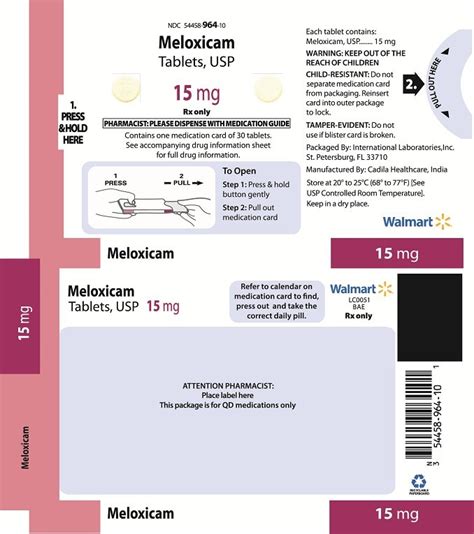Intro
Discover what Meloxicam is, a nonsteroidal anti-inflammatory drug (NSAID) used to treat pain, inflammation, and arthritis, with information on its uses, side effects, and interactions, as a COX-2 inhibitor for osteoarthritis and rheumatoid arthritis relief.
Meloxicam is a type of nonsteroidal anti-inflammatory drug (NSAID) that is commonly used to treat pain, inflammation, and stiffness in conditions such as osteoarthritis, rheumatoid arthritis, and ankylosing spondylitis. It works by blocking the production of prostaglandins, which are chemicals in the body that cause pain and inflammation. Meloxicam is available in various forms, including tablets, capsules, and injectable solutions, and is often prescribed under the brand name Mobic.
The importance of meloxicam lies in its ability to provide relief from chronic pain and inflammation, which can significantly impact a person's quality of life. Chronic pain and inflammation can make everyday activities difficult, leading to feelings of frustration, anxiety, and depression. By reducing pain and inflammation, meloxicam can help individuals regain their independence and enjoy a more active lifestyle. Moreover, meloxicam has been shown to be effective in reducing the risk of gastrointestinal complications associated with long-term NSAID use, making it a popular choice among healthcare professionals.
Meloxicam has been extensively studied, and its effectiveness has been demonstrated in numerous clinical trials. These studies have shown that meloxicam is comparable to other NSAIDs in terms of efficacy, but with a lower risk of gastrointestinal side effects. Additionally, meloxicam has been found to be well-tolerated, with most patients experiencing few or no side effects. As a result, meloxicam has become a widely prescribed medication for the treatment of various inflammatory conditions.
How Meloxicam Works

Meloxicam works by inhibiting the enzyme cyclooxygenase-2 (COX-2), which is responsible for the production of prostaglandins. Prostaglandins are chemicals that cause pain, inflammation, and fever. By blocking the production of prostaglandins, meloxicam reduces the amount of inflammation and pain in the body. This mechanism of action is similar to other NSAIDs, but meloxicam has a higher selectivity for COX-2, which reduces the risk of gastrointestinal side effects.
The pharmacokinetics of meloxicam are characterized by rapid absorption, high bioavailability, and a long half-life. After oral administration, meloxicam is rapidly absorbed, with peak plasma concentrations reached within 2-3 hours. The drug is extensively metabolized in the liver, with the majority of the dose excreted in the urine. The long half-life of meloxicam allows for once-daily dosing, which can improve patient compliance and reduce the risk of side effects.
Benefits of Meloxicam
The benefits of meloxicam are numerous, and include: * Effective relief from chronic pain and inflammation * Reduced risk of gastrointestinal complications * Well-tolerated, with few or no side effects * Convenient once-daily dosing * Available in various forms, including tablets, capsules, and injectable solutionsUses of Meloxicam

Meloxicam is used to treat a variety of inflammatory conditions, including:
- Osteoarthritis: Meloxicam is used to reduce pain, stiffness, and inflammation in the joints.
- Rheumatoid arthritis: Meloxicam is used to reduce pain, stiffness, and inflammation in the joints.
- Ankylosing spondylitis: Meloxicam is used to reduce pain, stiffness, and inflammation in the spine and other joints.
- Juvenile idiopathic arthritis: Meloxicam is used to reduce pain, stiffness, and inflammation in children with juvenile idiopathic arthritis.
Side Effects of Meloxicam
While meloxicam is generally well-tolerated, it can cause side effects in some individuals. Common side effects include: * Nausea and vomiting * Diarrhea * Abdominal pain * Headache * DizzinessSerious side effects, such as gastrointestinal bleeding and kidney damage, can occur, but are rare. It is essential to follow the recommended dosage and consult with a healthcare professional if any side effects occur.
Meloxicam Dosage

The dosage of meloxicam varies depending on the condition being treated and the individual patient. The recommended dosage for adults is 7.5-15 mg per day, taken orally. For children, the recommended dosage is 0.125-0.25 mg/kg per day, taken orally.
It is essential to follow the recommended dosage and consult with a healthcare professional if any questions or concerns arise. Meloxicam should not be taken for more than 10 days without consulting a healthcare professional.
Interactions with Other Medications
Meloxicam can interact with other medications, including: * Warfarin: Meloxicam can increase the risk of bleeding when taken with warfarin. * Aspirin: Meloxicam can increase the risk of gastrointestinal side effects when taken with aspirin. * ACE inhibitors: Meloxicam can increase the risk of kidney damage when taken with ACE inhibitors.It is essential to inform a healthcare professional about all medications being taken before starting meloxicam.
Meloxicam and Pregnancy

Meloxicam is not recommended during pregnancy, as it can cause harm to the fetus. Meloxicam can increase the risk of miscarriage, premature birth, and low birth weight. If meloxicam is necessary during pregnancy, the lowest effective dose should be used, and the patient should be closely monitored by a healthcare professional.
Meloxicam and Breastfeeding
Meloxicam is excreted in breast milk, and its effects on the nursing infant are unknown. Therefore, meloxicam should be used with caution in breastfeeding women, and the patient should consult with a healthcare professional before taking meloxicam.Meloxicam and Liver Disease

Meloxicam can cause liver damage, and its use should be avoided in patients with liver disease. Patients with liver disease should be closely monitored by a healthcare professional if meloxicam is necessary.
Meloxicam and Kidney Disease
Meloxicam can cause kidney damage, and its use should be avoided in patients with kidney disease. Patients with kidney disease should be closely monitored by a healthcare professional if meloxicam is necessary.What is meloxicam used for?
+Meloxicam is used to treat pain, inflammation, and stiffness in conditions such as osteoarthritis, rheumatoid arthritis, and ankylosing spondylitis.
How does meloxicam work?
+Meloxicam works by inhibiting the enzyme cyclooxygenase-2 (COX-2), which is responsible for the production of prostaglandins.
What are the side effects of meloxicam?
+Common side effects of meloxicam include nausea, vomiting, diarrhea, abdominal pain, headache, and dizziness. Serious side effects, such as gastrointestinal bleeding and kidney damage, can occur, but are rare.
In conclusion, meloxicam is a valuable medication for the treatment of various inflammatory conditions. Its effectiveness, safety, and convenience make it a popular choice among healthcare professionals and patients. By understanding how meloxicam works, its benefits, and its potential side effects, individuals can make informed decisions about their treatment options. If you have any questions or concerns about meloxicam, we encourage you to comment below or consult with a healthcare professional. Share this article with others who may benefit from this information, and take the first step towards managing your pain and inflammation today.
